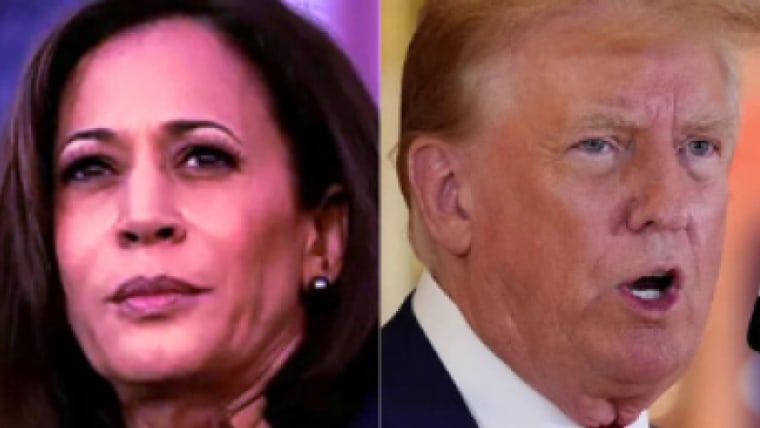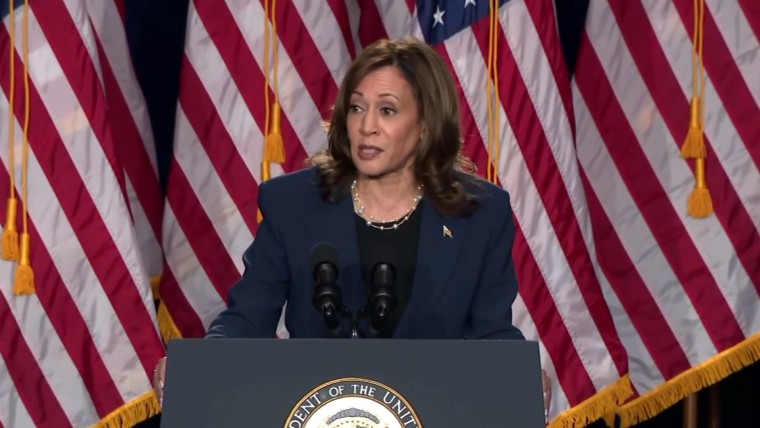When President Joe Biden announced that he had chosen to drop out of the race after a messy debate performance followed by an equally chaotic month, and endorsed Vice President Kamala Harris to be the nominee in his stead, Harris quickly racked up endorsements from major party figures and a majority of delegates. Barring any major development, she will be the Democratic nominee this fall.
Many Democrats saw this passing of the baton as a key moment to redefine a campaign in which the president had been lagging behind. For months, former President Donald Trump had led Biden in polling, both nationally and especially in critical swing states needed to win the presidency. Now an important question arises: Is Harris a stronger candidate than Biden?
Many Democrats saw this passing of the baton as a key moment to redefine a campaign in which the president had been lagging behind.
Ever since Harris’ kickoff of her 2020 presidential campaign, there have been a number of concerns that she would not be a particularly strong candidate. In fact, her campaign ended before the Iowa caucuses, which critics point to as an example of her weakness as a candidate. And her performance in polls against Trump often trailed behind other Democrats’, including Biden’s.
But as the 2024 campaign ramped up, there were signs of Harris’ increasing strength — or perhaps Biden’s growing vulnerabilities. Last fall, a New York Times/Siena College poll found Harris slightly outpolled Biden in swing states, thanks to her relative strength with Democratic-leaning groups with whom Biden had shown unprecedented weaknesses. These voters, often young and nonwhite, backed Democratic candidates for Congress and Harris, but not Biden.
In the 2020 primary, Biden often outperformed all of his rival Democrats in polls against Trump. But after Biden’s June debate performance, a flurry of polls that measured both Biden and Harris have been decidedly more mixed.
For our analysis, we will examine seven post-debate national polls that were conducted by “select pollsters” that meet The New York Times’ standard for high-quality analysis, plus an additional national poll conducted by Split Ticket/Data for Progress. Of these eight, Harris outperformed Biden in two, ran even with him in two, but performed worse than him in four. Only one poll found the difference between the candidates to be greater than 2 points in either direction.
On the state level, what limited evidence we have is similarly mixed. The New York Times and Siena College conducted a poll in Pennsylvania and Virginia that found Harris outrunning Biden by 2 points in both states. An Emerson College poll of Virginia, however, found no difference between the candidates. Unfortunately, those three polls are the extent of high-quality state polls since the June 27 debate.
From the polls reviewed, it can be concluded that Harris performs better than Biden, particularly due to strength with young voters and nonwhite voters, two Democratic-leaning groups that have been hesitant in supporting the president but not in their support for the vice president (and some other Democrats). Despite this small polled overperformance, Harris, like Biden, still polls behind Trump. In the past few weeks, Trump led Biden in polls of Michigan, Wisconsin and Pennsylvania, albeit narrowly, while in Sun Belt states like Arizona, Nevada and Georgia, Trump’s advantage ballooned out into the upper single digits, thanks to his newfound polled strength with previously Democratic nonwhite voters. Even if Harris gained a point or two over Biden in all six states, she would still be reliant on a narrow path to the presidency that is conditional on sweeping the three Midwest swing states.
But Harris gaining equally in all six states is not likely; in fact she is more likely to gain in the Sun Belt, where disaffected Democrats are younger and less white than in the Rust Belt. This makes any coalitional gains for her even less efficient than they might appear. More specifically, even if Harris’ strength with these disengaged voters is real, she would have an outsize impact only in the states where Biden’s numbers have already put Democrats in a very weak position. A surge in nonwhite support would, by contrast, have a far more limited effect in Michigan or Wisconsin, meaning Harris may be put in a position where she narrowly falls short of victory in the the Sun Belt despite considerable gains, while the Rust Belt result versus Biden’s hypothetical November performance remains almost unchanged.

There’s also a case to be made that the president is the stronger candidate. Although Biden has since bowed out of the race, and almost certainly will not return to the ticket, we shouldn’t ignore some of his unique strengths that Harris may not share. He had already demonstrated his ability to defeat Trump once in 2020; and his poll numbers among white voters and the elderly were on par with those from his 2020 victory — at times, better than what Harris saw. In fact, the groups he had slipped the most with were core Democratic groups, ones that would be most easily goaded back into the coalition as November drew nearer, and the possibility of a second Trump presidency could have been an effective rallying cry for the incumbent president. It is entirely possible that the advantages enjoyed by Harris are simply through winning a greater share of voters who would have “come home” to either candidate.
We may never know the answer, but July came to a close with little evidence that these voters had begun the process of returning to Biden — which is why Harris would occasionally outperform him in polls. The strongest case for Biden, then, was that he had already established a “good” baseline among voters least friendly to Democrats, and that his catastrophic numbers with young and nonwhite voters was something of a mirage that would disappear by Election Day. In polling so far, Harris’ strengths relative to Biden’s mostly come from the latter group.
Biden also demonstrated regional strength in Northeastern states like Pennsylvania, New Hampshire and Maine, where many counties swung toward Trump in 2016, but then back toward Democrats when Biden was on the ticket in 2020. This helped deliver a decisive win for Biden in states where Hillary Clinton lost or came close to losing in 2016. As a former senator from California, Harris is much less likely to enjoy the same regional advantages Biden did in a part of the country with more swing states.
But the case for Harris is less about existing polls, which were asking an entirely hypothetical question of voters up until the Sunday Biden resigned. Instead, Harris gives Democrats an opportunity rarely afforded to a party at this point in the year: a chance to reset the campaign.
Harris’ potential to re-energize disaffected Democrats could also go undetected by polls.
In fact, Harris’ potential to re-energize disaffected Democrats could also go undetected by polls. Because polls depend on a representative model of the electorate, a poll based on a Biden-Trump model could miss disengaged Democrats who would vote for Harris, but not Biden, potentially understating her true strength with the electorate. These demoralized Democrats could be skipping out on Biden for a number of reasons ranging from his age, which is broadly a concern for all voters, to his handling of the conflict in the Middle East, which is criticized by progressive Democrats, or his association by the electorate with double-digit percentage price increases since his inauguration, which is generally under scrutiny from moderate Democrats. Harris is not fully burdened by these factors, and as a breakout candidate, can more freely define herself to voters across the political spectrum dissatisfied with the Biden presidency.
Biden’s campaign had hoped that its poll numbers would turn around as public awareness of Trump’s many liabilities, ranging from election denialism to his dozens of convictions, increased. Instead, the past month has largely revolved around Biden’s age and fitness for office. Harris, at 59, is unlikely to be dogged by this particular issue, and may even be successful in making Trump’s age, at 78, an issue for the former president.
But most importantly, Harris can clearly and cogently prosecute the Democrats’ case against Trump, unburdened by Biden’s personal liabilities. She may have a number of her own, and as vice president has already inherited the Biden administration’s unpopularity. It is also possible that she ends up becoming an even less popular figure than Biden, and her strength relative to him revealed to be a mirage. This does not invalidate previous conclusions made from polling top lines, but instead means that Harris may offer Democrats a better chance than Biden to change the party’s polling woes, and to fulfill their original goal of making the election a choice between themselves and Trump — instead of a referendum on Biden.
Although a Harris candidacy may introduce more uncertainties to the Democratic ticket, including a yet-unknown vice presidential nominee, when one is falling behind in a contest, the greater variability a fresh face can bring is exactly what’s needed to secure a win.
